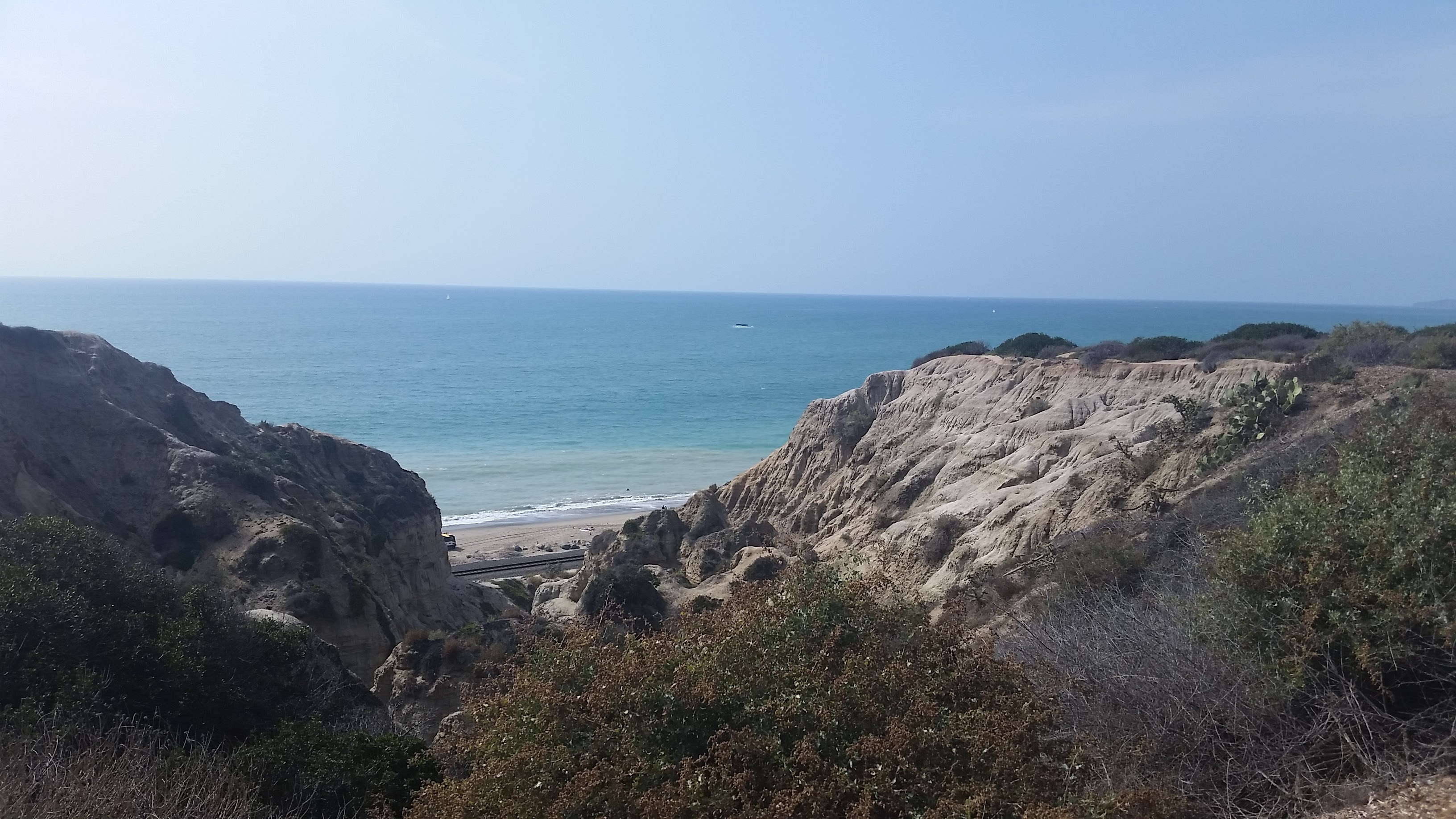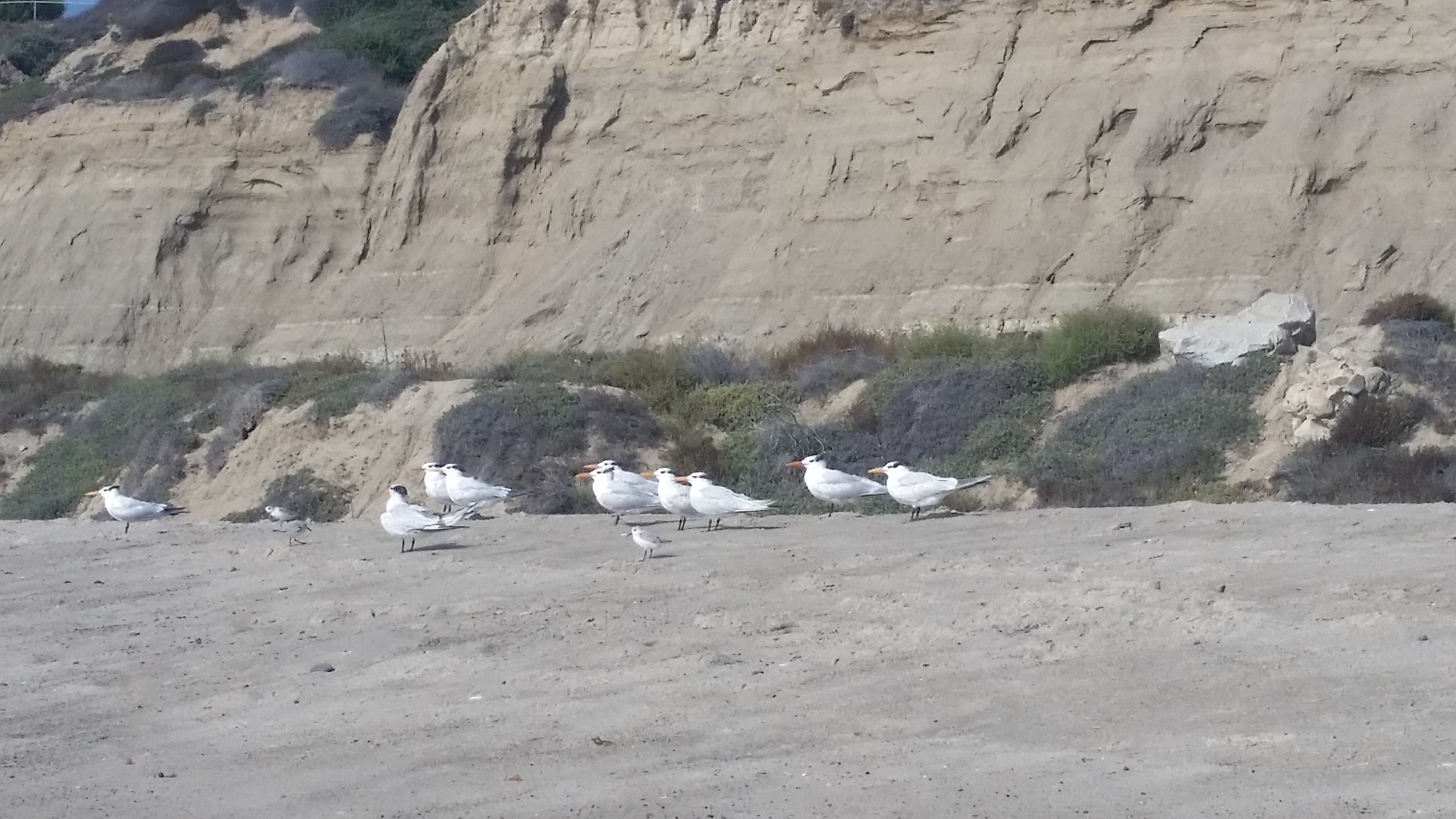
Dunes And Coastal Bluffs
Photo Credit: Emily Perkins, SDMMP

Dunes And Coastal Bluffs
Photo Credit: Emily Perkins, SDMMP
|
Adaptive Management of Coastal Sand Dunes in Mission Bay to Benefit Native Plants and the CA Least Tern
San Diego Bird Alliance (formerly San Diego Audubon Society) has been leading efforts to restore coastal sand dunes in Mission Bay for decades, largely focused on supporting nesting California Least Terns (Sternula antillarum browni), and rare and endangered sand dune plants such as Nuttall's Lotus (Acmispon prostratus) and Coast Wooly Head (Nemacaulis denudata). The primary threat to these species is the presence of fast-growing, nonnative vegetation, which takes up space that Least Terns require for nesting, and outcompetes native dune plants. Volunteer-led hand management of these sites has resulted in a dramatic reduction in invasive cover, and bi-annual vegetation monitoring has revealed that hand management is a more effective strategy in reducing nonnative growth than the more traditional mechanized scraping and broadcast herbicide application strategies. These results are being used to inform year-to-year site management, and to create longterm strategies for managing coastal dunes in Mission Bay. A portion of this project was funded by a SANDAG TransNet EMP Land Management Grant (Contract #5001967, #5004729, and #5005518).
|
|
California Least Tern Predator Monitoring (Ternwatchers)
Volunteer-based predator monitoring program at the nesting sites in Mission Bay. Citizen scientists are trained to monitor nesting sites for predators from mid-April through late May, with the program concluding the end of September.
|
|
North County Dunes Restoration
Phase I of this project focused on surveys and restoration activities at potential dune habitat between northern Carlsbad and northern La Jolla. This was in order to extend the range and increase the population of dune-dependent species, such as the California least tern, Western snowy plover, and Nuttall's lotus. Phase 2 will focus on the completion and implementation of the following site-specific restoration plan that was developed during the first phase of the project: the Cardiff State Beach Living Shorelines Draft Habitat Restoration Plan. In addition, SELC proposes to conduct invasive species management and support existing populations of special-status/native coastal dune and bluff plant species at South Carlsbad State Beach Campground.
|
|
Ocean Beach Estuary Enhancement Project
The project includes efforts to reduce threats to SO and SL species in the San Diego River estuary and allow human recreational use to coexist with high-quality habitat. The San Diego River estuary contains biologically valuable salt marsh and coastal dune habitats, which are increasingly rare in the region. Several SO and SL species occur in this project area including: salt marsh bird's beak, Nuttall's acmispon, western snowy plover, light-footed Ridgway's rail, and California least tern. The project will utilize management actions to minimize threats and encourage responsible human recreation including: improving access control through physical barriers to reduce threats of trampling, trash and illegal use, managing invasive weeds and planting native species to encourage pollinators of target native plant species, increasing community awareness through community education, and facilitating community investment with hands-on, meaningful volunteer projects, docent-led programs, and outreach, and growing a robust stewardship program to augment limited staff capacity for long-term maintenance of habitat and improvements.
This project is partially funded by SANDAG TransNet EMP Land Management Grant #S1125510
|
|
Vegetation Mapping 2025
The goal of this project is to create a new vegetation map for the western portion of San Diego County. This will be based on the Vegetation Classification Manual hierarchical classification system. The map will consist of a group-level comprehensive map based on satellite remote sensing and an alliance/association map focused on existing preserves or important resources.
|
|
Vegetation Mapping and Classification 2012
This project first created a vegetation classification system and manual. Then, based on 2012 data, this project completed 3 tasks: Task 1. Vegetation Mapping. Task 2. Invasive Nonnative Species Plant Mapping. Task 3. Tecate Cypress Mapping. In 2014, the data was updated based on user's comments. The final products are available to download in the data section.
|
|
Veldt Grass Removal - San Elijo Lagoon Ecological Reserve
The San Elijo Lagoon Conservancy (SELC) aims to secure funding to begin Phase I of eradicating perennial veldt grass (Ehrharta calycha) in the San Elijo Lagoon Ecological Reserve (Reserve). The invasive nonnative grass species currently occurs in Diegan coastal sage scrub, southern maritime chaparral, and riparian scrub habitats. It is also capable of invading coastal dune habitats, potentially displacing several high priority Management Strategic Plan (MSP) plant and animal species. SELC proposes to treat the current range of perennial veldt grass in the reserve and continue to monitor the spread or lack thereof. Perennial veldt grass ls currently under SMSP management level 3 for invasive non-native plants, and needs further evaluation and management information. The proposed project will provide crucial information regarding the species and the potential for its control and eradication.
|
The two types of coastal dunes in San Diego are active coastal dunes and foredunes. Active coastal dunes occur on barren, mobile sand accumulations [1]. The size and shapes of these formations are determined by abiotic site factors such as, wind direction and speed, site topography, sand source, and grain size, rather than by stabilizing vegetation. Coastal dunes are unvegetated and will often overrun adjacent foredunes. Foredunes are similar to active coastal dunes, but with less wind and/or a smaller supply of sand and/or more available groundwater. Foredunes are drier, slightly warmer, and exposed to weaker and less persistent onshore winds. A coastal bluff is a naturally formed precipitous landform that generally has a gradient of at least 200 percent (1:2 slope) with a vertical elevation of at least 10 feet [2]. The southern coastal scrub vegetation community exists on coastal bluffs [1]. Southern California bluff scrub is a low growing scrub up to 2 meters tall. The scrub forms continuous mats or may be more scattered. The vegetation consists of dwarf shrubs, herbaceous perennials, and annuals.
The coastal dunes alliance, Ambrosia chamissonis-Abronia maritima, occurs widely up and down the Pacific coastal strand of California and is restricted to the coastal dunes and beaches [3]. The most extensive strands occur from Silver Strand State Beach to the Tijuana River mouth. In this alliance, Abronia latifolia and/ or Ambrosia chamissonis mix with other perennial herbs, grasses, and low shrubs to form a low herbaceous canopy. Species characteristic of the foredunes include native plants such as: red sand verbena (Abronia maritima), beach sand verbena (A. umbellata), beach bur (Ambrosia chamissonis), beach salt bush (Atriplex leucophylla), beach morning glory (Calystegia soldanella), shruby beach primrose (Camissoniopsis cheiranthifolia suffruticosa), inland saltgrass (Distichlis spicata), and Menzie’s goldenbush (Isocoma menziesii), as well as nonnative plants such as European searocket (Cakile maritima) and iceplant (Carpobrotus edulis) [3]. The foredune vegetation community also includes the Ambrosia chamissonis-Abronia maritima-Cakile maritima Association. This association includes Ambrosia chamissonis with Abronia maritima or A. umbellata, and/or the nonnative Cakile maritima as dominants in a low herbaceous canopy. This vegetation type is limited to coastal dune habitats throughout San Diego County. Species characteristic of the coastal bluff vegetation community include natives such as: saltbush (Atriplex spp.), coast morning glory (Calystegia macrostegia ssp. cyclostegia), island morning glory (C. macrostegia), Indian paintbrush (Castilleja affinis), Orcutt’s spineflower (Chorizanthe orcuttiana), giant coreopsis (Leptosyne gigantean), sea dahlia (L. maritima), dudleya (Dudleya spp.), California encelia (Encelia californica), seaside golden yarrow (Eriophyllum staechadifolium), goldenbush (Ericameria spp.), cliff aster (Malacothrix saxatilis), chilicothe (Marah macrocarpa), coast prickly pear (Opuntia littoralis), and lemonade berry (Rhus integrifolia), as well as nonnatives such as sea fig (Carpobrotus aequilateralus) and crystalline iceplant (Mesembryanthemum crystallinum) [3].
Active coastal dunes are found along the Pacific Coast where sandy beaches are present and coastal headlands are absent [1].
Dunes and coastal bluff vegetation in the MSPA are included in the “other†vegetation community for mapping and acreage calculation, so the exact acreage of dunes and coastal bluffs in unknown.
The plants found on coastal sand dunes are primarily prostrate herbs with creeping stems and long taproots [4]. The leaves are typically small, somewhat succulent, and often hairy and grayish in color. These features aid the plants in tolerating drought, salt stress, and intense sunlight. The vegetation of foredunes is dominated by succulents, perennial herbs, and subshrubs [1]. The vegetation lacks perennial grasses, but has a higher proportion of subshrubs that grow up to 30 cm tall. Coverage varies from complete to scattered. Growth and flowering occur in early to mid-spring. Coastal bluff vegetation is exposed to varying, moisture-laden winds with high salt content. The soils on coastal bluffs are usually rocky and poorly developed.
Coastal dunes are dynamic habitats affected by waves, tides, wind, and trampling [4]. Dunes develop when there is a substantial amount of blown, dry sand. Coastal bluffs are escarpments or steep faces of rock, decomposed rock, or soil resulting from erosion, faulting, or folding of the land mass and are located in the coastal zone [2].
Coastal dunes in California have been significantly threatened and reduced by development, off road vehicle use, and exotic species invasion [4]. Human disturbance and competition for the use of beaches by beach-goers can endanger birds that rely on beaches for nesting habitat, such as the least tern (Sternula antillarum) and snowy plover (Charadrius nivosus) [5]. Coastal bluffs are threatened by the increasing pressure to develop shorelines, as well as a number of natural processes. High tides and large waves can contribute to cliff failure and can threaten the coastal scrub bluff vegetation community. Large waves facilitate coastal bluff erosion by removing protective beach sediment and allowing waves to directly attack the toe cliff [6]. Moderate-to high-intensity ENSO events can elevate sea levels and lead to high wave energy, which can cause sea-cliff erosion and shoreline recession. Problems from coastal bluff failures have emerged from Torrey Pines to San Onofre [7]. In March 2016 a large sea cave opened up beneath a Carlsbad bluff, and in August 2018 large chunks of the Del Mar cliffs collapsed, impacting train traffic and narrowly missing sunbathers below [8].
[1] Oberbauer, T. A., M. Kelly, and Jeremy Buegge. 2008. Draft Vegetation Communitties of San Diego County. Based on “Preliminary Descriptions of the Terrestrial Natural Communities of Californiaâ€, Robert F. Holland, Ph.D., October 1986. San Diego, CA.
[2] The City of San Diego. 2000. “Land Development Code Coastal Bluffs and Beaches Guidelines.†San Diego, CA. https://www.sandiego.gov/sites/default/files/legacy/developmentservices/pdf/industry/landdevmanual/ldmcoastal.pdf.
[3] Sproul, F., T. Keeler-Wolf, P. Gordon-Reedy, J. Dunn, A. Klein, and K. Harper. 2011. Vegetation Classification Manual for Western San Diego County. First. San Diego, CA
[4] Cheadle Center for Biodiversity & Ecological Restoration. n.d. “Coastal Dune.â€
[5] Audubon. n.d. “Priority Birds.†Guide to North American Birds. https://www.audubon.org/birds/priority.
[6] Storlazzi, Curt D, and Gary B Griggs. 2000. “Influence of El Niño – Southern Oscillation ( ENSO ) Events on the Evolution of Central California ’ S Shoreline,†no. 2: 236–49.
[7] Diehl, Phil. 2016. “Erosion Makes Coastal Bluffs Dangerous.†San Diego Union Tribune. http://www.sandiegouniontribune.com/news/environment/sdut-erosion-makes-coastalbluffs-dangerous-2016mar24-htmlstory.html.
[8] Self, Zac, and Rina Nakamo. 2018. “Cliff Collapses in Del Mar, Briefly Halting Train Traffic.†10 News. https://www.10news.com/news/cliff-collapses-in-del-mar-halting-train-traffic.